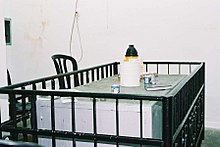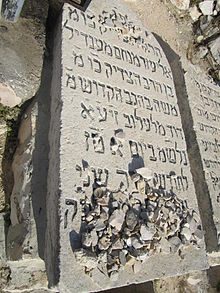Lelov: Difference between revisions
No edit summary |
How did he establish the court a year after he died? 1815 or 1814 Tags: Visual edit Mobile edit Mobile web edit |
||
| Line 1: | Line 1: | ||
'''Lelov''' ({{lang-he|לֶעלוֹב}}) is a Polish-Israeli [[Hasidic]] [[Hasidic dynasties|dynastic]] court, which traces its origins to the town of [[Lelów]], [[Poland]] where the court was established in 1815 by Rabbi Dovid Biderman (1746-1814). |
'''Lelov''' ({{lang-he|לֶעלוֹב}}) is a Polish-Israeli [[Hasidic]] [[Hasidic dynasties|dynastic]] court, which traces its origins to the town of [[Lelów]], [[Poland]] where the court was established in 1815 by Rabbi Dovid Biderman (1746-1814). |
||
The Lelover dynasty migrated from Poland to [[Jerusalem]] when Rabbi Dovid's son, Rabbi Moshe Biderman (1776-1851), moved there in the last year of his life. Rabbi Moshe Biderman of Lelov was the son-in-law of Rabbi [[Yaakov Yitzchak Rabinowicz]], known as the Yid Hakudosh (Holy Jew) of [[Peshischa]]. Since then the Hasidism bore a Jerusalem character and has become part of the [[Old Yishuv]]. Today there are several descendants as Lelover Rebbes, in [[Bnei Brak]], [[Jerusalem]], |
The Lelover dynasty migrated from Poland to [[Jerusalem]] when Rabbi Dovid's son, Rabbi Moshe Biderman (1776-1851), moved there in the last year of his life. Rabbi Moshe Biderman of Lelov was the son-in-law of Rabbi [[Yaakov Yitzchak Rabinowicz]], known as the Yid Hakudosh (Holy Jew) of [[Peshischa]]. Since then the Hasidism bore a Jerusalem character and has become part of the [[Old Yishuv]]. Today there are several descendants as Lelover Rebbes, in [[Bnei Brak]], [[Jerusalem]], |
||
Revision as of 15:36, 22 September 2019
Lelov (Hebrew: לֶעלוֹב) is a Polish-Israeli Hasidic dynastic court, which traces its origins to the town of Lelów, Poland where the court was established in 1815 by Rabbi Dovid Biderman (1746-1814).
The Lelover dynasty migrated from Poland to Jerusalem when Rabbi Dovid's son, Rabbi Moshe Biderman (1776-1851), moved there in the last year of his life. Rabbi Moshe Biderman of Lelov was the son-in-law of Rabbi Yaakov Yitzchak Rabinowicz, known as the Yid Hakudosh (Holy Jew) of Peshischa. Since then the Hasidism bore a Jerusalem character and has become part of the Old Yishuv. Today there are several descendants as Lelover Rebbes, in Bnei Brak, Jerusalem,




History
Rabbi Dovid of Lelov was a disciple of the Seer of Lublin, a disciple of Rabbi Elimelech of Lizhensk, who was a disciple of the Magid of Mezritsh, the successor to and leading disciple of the Baal Shem Tov, the founder of Hasidism.
There is a Hasidic legend that Napoleon Bonaparte asked Rabbi Dovid of Lelov if he would be successful in his conquest of Russia. The rebbe told the Emperor that he would not. After Napoleon's defeat, he allegedly passed through Lelov and told the Rebbe that he was indeed correct. He then gave the Rebbe his velvet cloak. The Hasidim say that Rabbi Moshe of Lelov, the son of Rabbi Dovid, took the cloak to Jerusalem with him, and made the cover for the Holy Ark in his synagogue from it.[1]
The early Lelover Rebbes (starting with Rabbi Dovid Tzvi Shlomo) were followers of the Karliner Rebbe; whenever the latter came to Land of Israel, the Lelover Rebbe would go to visit him.
Outline of Lelover dynasty
- Grand Rabbi Dovid of Lelov (1746-1814)
- Grand Rabbi Moshe Biderman of Lelov (1776-1851)
- Grand Rabbi Eleazar Mendel Biderman of Lelov (1827-1882)
- Grand Rabbi Dovid Tzvi Shlomo Biderman of Lelov (1844-1918)
- Grand Rabbi Shimon Noson Nuta Biderman of Lelov (1870-1929)
- Grand Rabbi Pinchos Chaim Biderman of Lelov
- Grand Rabbi Moshe Mordechai Biderman of Lelov and Karlin (1903-1987). Rebbe (in Tel Aviv) for many years, later moving to Bnei Brak, where he prayed in the beis medrash of his son, Rebbe Alter Elozor Menachem. The children of Rabbi Moshe Mordechai are: Rebbetzin Chana Kopp, Reb Avrohom Shlomo, Rab Dovid Tzi Yisroel (1933-1993), Rebbetzin Rivka Aroonchik, Reb Pinchos Yitzchok (the Rebbe of Nikolsburg), Reb Alter Elozor Menachem, Reb Berel, Reb Shmelke, Rebbetzin Nechama Ruchama. (One child died of hunger while the family lived in Jerusalem's old city. Avraham Parshan a public service activist became aware of the rabbi's children's poor condition through Yosef Eliyahu Deutch and they worked to alleviate the rabbi's financial hardship).
- Grand Rabbi Avrohom Shlomo Biderman of Lelov-Jerusalem (Zephania Street) (1927-2000). Oldest son of Rebbe Moshe Mordechai. Son in law of Rebbe Yehuda Zundel Hager of Savran.
- Grand Rabbi Avrohom Shlomo Biderman of Lelov-Jerusalem (Zephania Street) (1927-2000). Oldest son of Rebbe Moshe Mordechai. Son in law of Rebbe Yehuda Zundel Hager of Savran.
-
- Grand Rabbi Alter Elozor Menachem Biderman of Lelov in Bnei Brak (1935-2001). Studied in the Tiferes Tzion yeshiva in Bnei Brak, where he was very close to the Chazon Ish. In 1958, he married the daughter of Rabbi Shimon Aharon H'Grand Rabbi Yaakov Yitzchok Biderman of Lelov.
- Grand Rabbi Shimon Noson Nuta Biderman of Lelov (1870-1929)
-
- Grand Rabbi Yaakov Yitzchok Biderman of Lelov (current)
- Grand Rabbi Dovid Tzvi Shlomo Biderman of Lelov (1844-1918)
- Grand Rabbi Eleazar Mendel Biderman of Lelov (1827-1882)
- Grand Rabbi Moshe Biderman of Lelov (1776-1851)
This section needs expansion. You can help by adding to it. (February 2019) |
Rabbi Dovid Biderman
Rabbi Dovid Biderman (1746 - 7th of Sh'vat, 5574; 1814) was the founding Rebbe of the Chasidic court of Lelov.
Rabbi Moshe Biderman
Rabbi Moshe Biderman (1777-1851) was the second Admor of the Chassidic dynasty of Lelov, who headed it from the year 1814 until his death in 1851.

Rabbi Elazar Mendel Biderman
Rabbi Elazar Menachem Mendel Biderman (1827 - 16 Adar II 5643; 1883) was the third Rebbe of Lelov.
Rabbi Dovid Tzvi Shlomo Biderman
Rabbi Shimon Noson Nuta Biderman (the first)
Rabbi Moshe Mordechai Biderman
== Rabbi Alter Eluzer Menachem
== Grand Rabbi Yakov Yitschok Biederman Current
See also
References
- A Chassidic journey : the Polish Chassidic dynasties of Lublin, Lelov, Nikolsburg and Boston. Based on Shalsheles Boston by Meir Valach, translated by Eliezer Shore. New York : Feldheim, 2002 ISBN 978-1-58330-568-3
